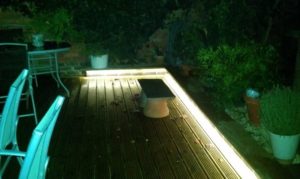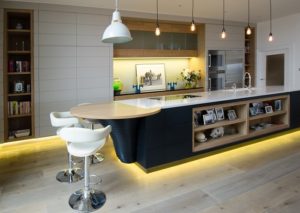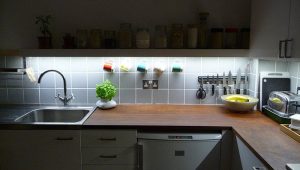Feature Lighting – how to create accent lights & highlights with LEDs
When we talk about LED lighting installations, a lot of words and ideas get thrown around. Some are obvious, but others raise more questions than they answer.
So to clear up any confusions, we’ve put together a few notes on some of the common LED feature-lighting concepts and phrases you may come across.
What is LED coving lighting?
Coving lighting describes LED lighting that is installed around the top edge of a wall or the outer edge of a ceiling. It is usually fitted in a continuous strip (often a ring circuit) – to up-light or down-light the top edge of the ceiling, spilling the light down the wall or up onto the ceiling.
An alternative cove lighting option is to use a drop-down ceiling. You can create a drop-down ceiling using plasterboard (or other materials) to give the appearance of a lower ceiling above most of the room, leaving areas by the walls where LED strip lights can be installed. This will give you a halo glow all around the room, to produce a stunning effect of a floating ceiling.
A continuous light source
LED strip lights are an ideal solution for coving lighting because they’re a continuous light source: very slim and narrow, and available in a wide range of colours, brightnesses etc so that you can choose exactly the light and ambience you want. Cove lighting can be created anywhere – it’s a particularly popular feature in hotels, restaurants and homes.
Instyle’s 5-watt LED strips are our most typically-used product for feature lighting in covings. Our 10-watt LED strips are also popular, and are often installed together with a mains-dimmable transformer to give the customer the option of dimming/brightening. If you prefer RGB cove lighting, then our 7.5w colour-changing LED strip lights are ideal. Check out this video…
Our ‘positioning LED lights’ support page has more info on the best way to fit your coving LEDs.
LED ceiling lights
As well as feature lighting, ceiling lights can also be used to give a room full ‘working light’ brightness. In that case, you should use 12w, 20w or even our 24w LED strip lights. (24w LEDs are VERY bright – we suggest them for use in daylight locations or very large spaces!)
You can choose from a variety of controls to manage your ceiling lights – such as TRIAC (mains dimming), DALI, or 0-10v dimmers.
LED lighting in the garden
LED strip lights are a great way to enhance the look of any garden. We can supply you with IP67-rated LED tape, which is certified fully waterproof. (Be aware that it’s not designed to be fitted in a submerged location though!)
Another possibility is to use LEDs to trim and decorate your decking, which will give the feel of a ‘floating’ decking area. LED strip lights are also great for marking out your garden and highlighting its features. Mounted in aluminium profiles, they’re also ideal for installation in glass fencing panels.
LED Bathroom lighting
LED strip lights work brilliantly for bathroom lighting, where they can be used for many different applications. Why not install them in the shower, mounted in aluminium extrusions, to create a unique lighting feature? Or in covings, to produce full-brightness ‘working light’. Or behind mirrors giving a halo effect (our 5w white LED strips are your best choice for mirrors, as more powerful LEDs can appear too stark and bright).
In bathrooms, we’ve found our customers tend to choose LEDs that produce a cool white light rather than warm white, in order to give a crisp clean feel.
LED lighting for bedrooms
Because they are small and discreet but very powerful, LED strips are frequently installed as wardrobe lighting. In bedrooms with a contemporary design, our strip lights are often mounted inside aluminium profiles to create a sleek finish.
For stunning colour-change highlights, our RGB LEDs can be installed as under-bed lighting to create a feature effect.
Kitchen lighting / plinth lighting using LEDs
See our ‘positioning LED lights’ support page to learn more about installing LEDs on plinths and kickboards.
Why choose LED strips for your signage features?
If you are involved in providing signage feature lighting, LED tape’s biggest advantage over fluorescent tubes and other alternatives is its very long life. Your LEDs will still be working @ 70% after 70,000 hours of continuous use. This can save hundreds – if not thousands – of pounds on maintenance costs. (Fluorescent tubes typically need changing every 2000 hours.) LED strip lights are essentially a fit-and-forget product, maintenance free.
The days of fixed lengths and rigid fluorescent tubes are long gone: LED tape is one of the most flexible light sources on the market, making it ideal for circular and curved signage. If necessary, linking cables between lengths can make your LED strip lights even more flexible, enough for lettered signage etc. And the tape is cuttable to the nearest 50mm, so it can fit any project. It can also be simply soldered back together again to create longer lengths.
Never forget that LED chips can be manufactured to order in any colour shade your signage needs. And there’s also RGB LED strip lighting, which can change colour instantly and is fully controllable using industry-standard DMX, wireless or even wifi protocols.
If your signage is mounted outdoors, you may want to consider using IP67 coated LED strips for reliable waterproofing.




